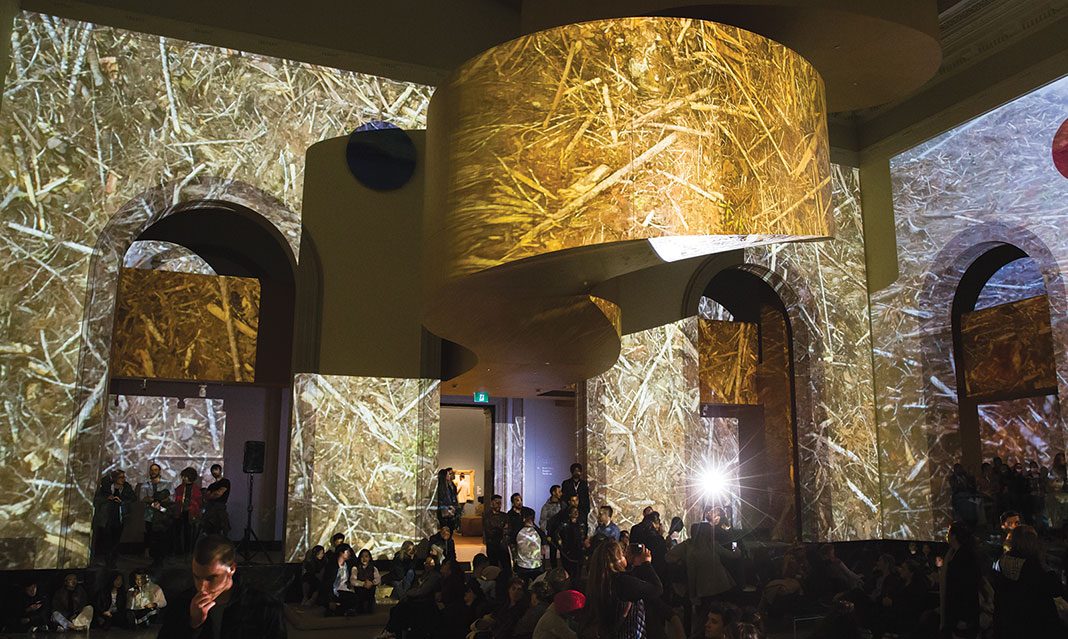Anthropocene, a new exhibition at the Art Gallery of Ontario (AGO) by photographer Edward Burtynsky and filmmakers Jennifer Baichwal and Nicholas de Pencier, explores the impact humans are leaving on the world.
Through a multimedia presentation, the artists travelled to 20 countries and captured the effects of human-caused environmental issues such as population density, mass consumption, and non-renewable resource extraction. The exhibition is a part of the multidisciplinary initiative The Anthropocene Project, which works alongside scientists around the globe who form the Anthropocene Working Group. The purpose of the project is to change the current geological epoch, which is a subdivision of the geological timescale that is longer than an age but shorter than a period, from Holocene to Anthropocene, acknowledging the impact humans are having on Earth.
As you enter the exhibition, you are instantly faced with a video installation of the Dandora Landfill in Nairobi, Kenya. The video follows a local worker walking through the landfill, with mountains of plastic and garbage surrounding them. The landfill was started in the 1970’s and was at capacity in 2001, but 2000 tonnes of waste are still dumped daily. The amount of garbage seems never-ending, immediately demonstrating the effects humans have on the environment.
Alongside short video clips are Burtynsky’s large scale photographs. The landscapes reveal areas around the world that have been changed by industry and human intervention. A notable image is “Lithium Mines #1, Salt Flats, Atacama Desert, Chile, 2017.” The photo is a stunning landscape of the world’s largest source of lithium, which is needed to make items such as batteries, glass, and even medication. The salt flats are whimsical shades of neon blue, yellow, and green, reflecting the different stages of extraction.
The allure of Burtynsky’s images are due in part to their grand scale. They capture locations that very few can personally witness, with viewpoints that capture infinite amounts of land. One example is the piece, “Tyrone Mine #3, Silver City, New Mexico, USA, 2012.” The wavy patterns and textured detail in the photograph of the mine are awe-inspiring, but this feeling changes after considering the long-term damage to the land’s ecosystems due to human activity.
A unique aspect of the exhibition is the use of film extensions and Augmented Reality. By downloading the app AVARA on a cell phone or tablet (iPads are also provided throughout the exhibition), visitors can interact with certain pieces.
Another large-scale photograph is entitled “Carrara Marble Quarries, Cava di Canalgrande #2, Carrara, Italy, 2016.” The image captures Carrara marble quarries in Italy, with an excavator in the centre of the photo. Pointing a device to the image using the app begins a video of the excavator at work, digging up the non-renewable resource. This adds another layer to the image, as you are watching humans directly interact with the environment, altering it forever. The technique is also used in “Mushin Market Intersection, Lagos, Nigeria, 2016,” a mural-sized image demonstrating population density. The film extensions reveal the bustling streets of Lagos, as thousands take over the area.
The Augmented Reality portion of the exhibition highlights aspects of the environment that have already disappeared. Directing your device’s camera to a box with the image of a rhinoceros, it transforms into a 3D sculpture of Sudan, the world’s last male northern white rhino who died last March. A similar box shape is on the opposite side of the exhibition with images of illegally poached elephant and rhino tusks that were confiscated by the Kenyan government. The tusks appear 3D like Sudan, but once you put your device down and look on the wall behind it, a video of the tusks being burned plays on a loop.
Anthropocene seamlessly integrates various mediums to present the impact we are having on the world. As you exit, information about decreasing your carbon footprint is shared along with an interactive question that asks how the exiting patron felt after viewing the exhibition in one word. At the time of my visit, the most popular response selected was “worried.”
Anthropocene runs at the AGO until January 6.



